Centauri Dreams
Imagining and Planning Interstellar Exploration
Close-up of an Extragalactic Star
While working on a piece about interstellar migration as a response to the accelerating expansion of the universe for next week, I want to pause a moment on a just announced observation. I’ve always had a fascination with the Magellanics, those satellite galaxies that are so useful to astronomers because their gravitational interactions with the Milky Way render both of them irregular in shape. That triggers waves of star formation and tells us something about how galaxies assemble themselves. The Small Magellanic Cloud (SMC), about 200,000 light years away, shows little structure, while the Large Magellanic (LMC) is a bit more organized but lacks symmetry – no smooth disk apparent there.
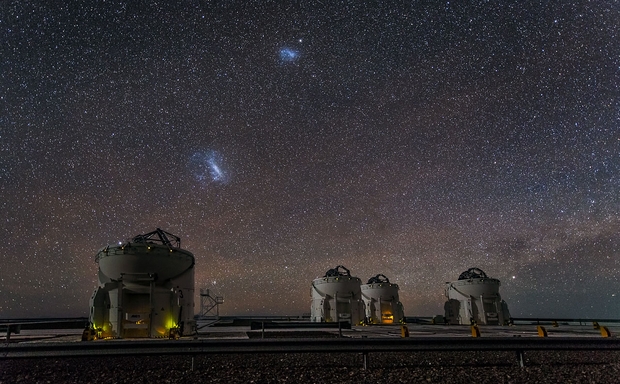
Image: This beautiful image taken at ESO’s Paranal Observatory shows the four Auxiliary Telescopes of the Very Large Telescope (VLT) Array, set against an incredibly starry backdrop on Cerro Paranal in Chile. The Auxiliary Telescopes are each 1.8 metres in diameter and work with the four 8.2-metre diameter Unit Telescopes to make up the world’s most advanced optical observatory. The telescopes work together to form the VLT Interferometer (VLTI), a giant interferometer which allows astronomers to see details up to 25 times finer than would be possible with the individual Unit Telescopes. Hanging over the site are the prominent Small and Large Magellanic Clouds, visible only in the southern sky. These two irregular dwarf galaxies are in the Local Group and so are companion galaxies to our own galaxy, the Milky Way. The image was taken by John Colosimo, who submitted it to the Your ESO Pictures Flickr group. Credit: ESO/J. Colosimo.
Within the LMC, some 160,000 light years away, astronomers have just imaged a rapidly evolving star, a fascinating catch because the object is dying and we apparently see it just before a supernova event. The telltale sign is the massive ejection of stellar material. The work was done with the European Southern Observatory’s Very Large Telescope Interferometer (VLTI), which combines the light collected by four telescopes, using the GRAVITY interferometer, correcting for atmospheric turbulence and providing imaging at four-milliarcsecond resolution. The effect is to produce the spatial resolution of a telescope of up to 130 meters in diameter depending on direction in the sky.
Long-studied and known as the ‘behemoth star,’ WOH G64 has shown surprising changes over a relatively short period of time. Keiichi Ohnaka (Universidad Andrés Bello, Chile) describes a star that is blowing out gas and dust in the last stages of its progress toward becoming a supernova: “We discovered an egg-shaped cocoon closely surrounding the star. We are excited because this may be related to the drastic ejection of material from the dying star before a supernova explosion.” Co-author Jacco van Loon (Keele University, UK) adds: “This star is one of the most extreme of its kind, and any drastic change may bring it closer to an explosive end.”
Shedding their outer layers, a red supergiant may take thousands of years to lose material before a supernova actually occurs. According to the paper, red supergiants like WOH G64 experience mass loss rates as high as ∼10−4 M☉ yr−1 — that means the star at this stage is losing on the order of 0.0001 solar masses of material every year. Recent work on other supernovae tell us that the mass-loss rate increases significantly just before the supernova event. It’s also intriguing that some red supergiants at this point of development show mass loss that is not symmetric. As far as I can find, the explanation is that the star is likely interacting with a binary companion. And indeed the paper notes:
The compact emission imaged with GRAVITY and the near-infrared spectral change suggest the formation of hot new dust close to the star, which gives rise to the monotonically rising near-infrared continuum and the high obscuration of the central star. The elongation of the emission may be due to the presence of a bipolar outflow or effects of an unseen companion.
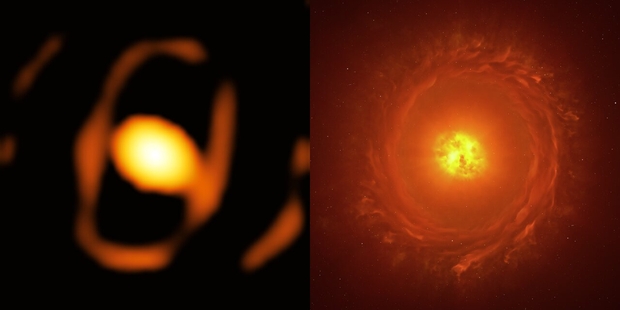
Image: Located in the Large Magellanic Cloud, at a staggering distance of over 160 000 light-years from us, WOH G64 is a dying star roughly 2000 times the size of the Sun. This image of the star (left) is the first close-up picture of a star outside our galaxy. This breakthrough was possible thanks to the European Southern Observatory’s Very Large Telescope Interferometer (ESO’s VLTI), located in Chile. The new image, taken with the VLTI’s GRAVITY instrument, shows that the star is enveloped in a large egg-shaped dust cocoon. The image on the right shows an artist’s impression reconstructing the geometry of the structures around the star, including the bright oval envelope and a fainter dusty torus. Confirming the presence and shape of this torus will require additional observations. Credit: ESO/K. Ohnaka et al., L. Calçada.
I suspect that Centauri Dreams readers will remember the Large Magellanic Cloud as the apparent next destination of the interstellar interloper Rama in Arthur C. Clarke’s Rendezvous with Rama (1973). My own favorite reference is Iain Banks’ The Player of Games (2009), where an incredibly complex gaming strategy must be tackled by the protagonist within a strange empire in the Small Magellanic Cloud. Whatever your preference, the Masgellanics continue to fascinate, and we should learn more from the VLTI as the upgraded GRAVITY+ comes online.
The paper is Ohnaka et al., “Imaging the innermost circumstellar environment of the red supergiant WOH G64 in the Large Magellanic Cloud,” Astronomy & Astrophysics 14 October 2024 (letter to the editor). Abstract.

Star Harvest: Civilizations in Search of Energy
Living a long time forces decisions that could otherwise be ignored. This is true of individuals as well as societies, but let’s think in terms of the individual human being. Getting older creates survival scenarios as simple as ensuring safety and nutrition for the elderly. But let’s extend lifetimes to centuries and beyond. In this thought experiment, we create a society of people so long-lived that their personal planning takes in events like a possible asteroid strike in 200 years. A person who could live for a billion years has to think in terms of surviving a dying Sun engulfing his or her planet.
If we assume a kind of immortality, the individual and the society merge in terms of their key concerns. It’s hard to imagine biological beings living for lifetimes like these, but as we’ve often considered in these pages, non-biological machine intelligence, constantly upgrading and improving itself, should be able to pull it off. Because we know of no extraterrestrial civilizations, we can only speculate, but the speculation is a good way to override our anthropomorphic prejudices. And it’s safe to say that any being or society will try to preserve itself in the event of local catastrophe.

Thus the needed insurance of interstellar migration, which philosopher Clément Vidal (Center Leo Apostel, Vrije Universiteit Brussel, Belgium) thinks might involve journeys vast enough to reach places where stars are as plentiful as in the globular clusters surrounding the Milky Way’s hub. Or galactic center, where resources abound and the need for frequent migrations is thus eased. If a culture like this spreads life through its own variant of panspermia, so much the better. I leave the motivations of a machine culture spreading biological life to science fiction authors, but believe me, there’s a cool plot in there somewhere. Someone should run with it.
Vidal’s idea of a stellar engine seizes on an unusual astronomical object, the so-called spider pulsar. We looked briefly at these last time, but let’s dig deeper. We imagine a civilization (Vidal calls them ‘stellivores’) that uses a low-mass star in its home system as a source of fuel, gradually consuming the star’s energies by accretion. So far so good, as we know that accretion is a well established phenomenon. It occurs, for example, in the formation of a Type 1a supernova, where a white dwarf reaches the Chandrasekhar limit (1.4 solar masses or so), drawing in material from a companion red giant through the process. Soon we have runaway nuclear fusion and a bright new object for astronomers to study.
A spider pulsar, a one millisecond pulsar with a very low-mass companion star, can interact not just through accretion but in some cases through evaporation. In reading Vidal’s new paper, I’ve been puzzled by this process, which actually can alternate with accretion in some instances. Things get complicated and quite interesting. Vidal explained in an email that evaporation becomes the primary process when a neutron star has a strong wind that actually quenches accretion and causes the move toward evaporation. Adds Vidal:
The astrophysical reason this would happen is after a long accretion journey, the companion star would get lighter and lighter, the orbit would shrink, up to the point where it is exposed to the strong pulsar wind and radiation. Then the dynamics would switch from accretion to evaporation. A subclass of (redback) spider pulsars, transitional millisecond pulsars, have their accretion that starts and stops abruptly. This is a fascinating phenomenology that has been studied intensively.
And indeed it has, as witness, for example, Baglio et al., “Matter ejections behind the highs and lows of the transitional millisecond pulsar PSR J1023+0038” (citation below), where I read:
Transitional millisecond pulsars are an emerging class of sources that link low-mass X-ray binaries to millisecond radio pulsars in binary systems. These pulsars alternate between a radio pulsar state and an active low-luminosity X-ray disc state. During the active state, these sources exhibit two distinct emission modes (high and low) that alternate unpredictably, abruptly, and incessantly. X-ray to optical pulsations are observed only during the high mode. The root cause of this puzzling behaviour remains elusive.
But back to spider pulsar terminology. You probably noticed the reference to ‘redback’ pulsars. Astronomers divide spider pulsars into black widows, where the companion star is in the range of 0.01 to 0.1 stellar masses, and redbacks, where the companion star mass is between 0.1 and 0.7 stellar masses. Again, the phenomenon Vidal homes in on is evaporation, and it is at the core of the concept of using such a system as an engine. Suppose we look at a transition millisecond pulsar – one of those switching between emission modes – and consider it within the possibility that it is an engine.
Asymmetric heating could be our technosignature as a millisecond pulsar adjusts the heat of its companion star by moving between accretion and evaporation modes to perform, for example, steering maneuvers outside the orbital plane. Asymmetric heating in varying accretion and evaporation phases can compensate for increases in orbital separation. In Vidal’s view, the goal of the binary stellar engine might be to capture a new star whose energies can now be used to supplant the depleted companion and supply the needs of the engine’s creators. Thus the civilization travels to a new star. We imagine a billion-year culture in constant journey mode in search of energy, with the entire galaxy in range.
When we find objects in our data that show transitional millisecond pulsars in configurations that are suggestive, how do we distinguish between technological activity and natural phenomena? As with all technosignatures, it’s not an easy call. As Vidal notes in his email: “Now the game is to make predictions starting with (1) natural, astrophysical hypotheses and models, and (2) artificial, intelligent, “spider stellar engine” hypotheses and models, and see which predictions turn out to be correct.”
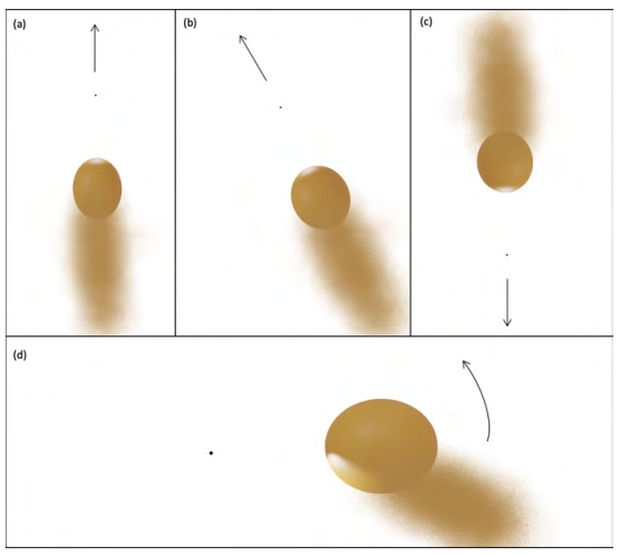
Image: This is Figure 1 from the paper. Caption: Four steering configurations of the binary stellar engine. Figures (a-c) are top views, face on, while figure (d) is side on. In situation (a) the stellar engine is accelerating or cruising; in situation (b), assuming the system velocity is towards the top, the thrust creates a force towards the left; in situation (c), assuming the system velocity is towards the top, the thrust creates a decelerating force. Situation (d) changes the orbital plane by asymmetric heating of the companion, which creates a lifting force in relation to the orbital plane. Note that the pulsar size and orbital separation are not to scale.
The mechanics of acceleration, steering and deceleration are intricate and fully described in the paper, which also includes information on other types of stellar engines going back to the original Shkadov concept – that chart is fascinating. In addition the paper analyzes candidate stellar engines that can be investigated for possible signs of intelligent control. But notice what kind of civilization we may be talking about here. After all, the payload of a spider engine is the millisecond pulsar, the propellant the low-mass companion star. We are thus considering postbiological intelligence on the neutron star itself. I want to quote Vidal’s email on this subject:
…[W]hat really matters is not the hardware of life, but what it does, its software, its functions. Recently we’ve seen with large language models that some form of intelligence can run on computer hardware. Of course, we could change this hardware multiple times and still have the same ChatGPT answering our questions. Life on Earth started with biochemical reactions, now we use semiconductor technology to process data, and we might see optical or quantum hardware taking over in the near future. If a civilization is on a billion-year long track to optimize its hardware and makes the most of the computational capacity of matter in the universe, it would likely continue to improve its hardware using more and more compact, high energy solutions such as nuclear reactions or subnuclear reactions (i.e. neutron star stuff). This is the level I imagine those stellivores are at. So, no planet, no individual traveler. Rather an integrated organism organized around high energy (sub)-nuclear reactions. It might still have some sub-organizations like species, nations, etc. but these would be at extremely small scales and impossible for us to detect.
As with all Vidal’s work, this paper is intricate and deeply researched. About spider engine maneuvering I have had the time only to cover the basics, and encourage interested readers to go to the paper, and also to mine the background laid out in Vidal’s magisterial 2014 title The Beginning and the End: The Meaning of Life in a Cosmological Perspective (Springer). The search for technosignatures demands moving far beyond the assumptions ingrained in our perspective as a species in technological infancy. No one works this turf better and with more elegance than Clément Vidal.
The paper is Vidal, “The Spider Stellar Engine: a Fully Steerable Extraterrestrial Design?” Journal of the British Interplanetary Society Vol. 77 (2024), 156-166 (full text). The Baglio paper is “Matter ejections behind the highs and lows of the transitional millisecond pulsar PSR J1023+0038,” Astronomy & Astrophysics Vol. 677, A30 (September 2023). Abstract. See also Papitto et al., “Transitional Millisecond Pulsars,” in Millisecond Pulsars, edited by Sudip Bhattacharyya, Alessandro Papitto, and Dipankar Bhattacharya, 157–200. Astrophysics and Space Science Library. Cham: Springer International Publishing.

Clearing the Air
I’ve played around a bit with Bluesky in the past, but have now decided it’s time to make a move. Those of you who have been following the site on X will want to know about the change, as posted in my first new Bluesky ‘skeet’ in some time. The change in user experience is striking, a bit like walking in an alpine meadow after spending years in a subway car. Not that I have anything against subways…
Have decided to move to BlueSky for good, having left X for obvious reasons. Future posts from my Centauri Dreams site will be linked here. Current post considers Clément Vidal's striking concept for using millisecond pulsars to move entire stellar systems. www.centauri-dreams.org/2024/11/14/a…
— Paul Gilster (@gilster.bsky.social) November 16, 2024 at 8:30 AM
Addendum: For those who have asked, this affects only those of you who are connected to me on X, which I no longer use. If you don’t use X, nothing has changed in how you see Centauri Dreams.

A Millisecond Pulsar Engine for Interstellar Travel
Suppose you want to migrate to another star, taking your entire civilization with you. Not an easy task given our technology today, but let’s remember that in the 13 billion year-plus history of the Milky Way, countless stars and their planets have emerged that are far older than our 4.6-billion year old Sun. If we imagine an intelligence that survives for a billion years or more, we can hardly put constraints on what it might accomplish. The idea of moving a star with its planetary system intact is out there on the edge of what science fiction can accomplish, if not yet science. There have even been SETI searches for such projects, though as with SETI at large, no hits.
Why would you want to move a star? Consider that if you are a long-lived species with a simple interest in exploring the universe, setting up a journey in which you can take your culture with you – all of it – could have serious appeal. For one thing, you are also taking your primary energy source with you, and can now settle into a traveler’s frame of mind, confident of reaching exotic destinations sooner or later. Slow boat to the heart of the Laniakea Supercluster, and imagine the sights to be had along the way.
Imagine a culture in which extraordinarily long lifetimes – perhaps ‘immortality’ for a machine civilization – is the norm. The accelerated expansion of the universe will continue rendering some destinations unreachable. Dan Hooper, in a paper called “Life Versus Dark Energy: How An Advanced Civilization Could Resist the Accelerating Expansion of the Universe,” considered this in 2018; we’ll be looking at his ideas in the near future. Perhaps migrating to a globular cluster or into the tightly packed center of a galaxy would suggest itself as a goal worth achieving. But let’s not dig too far into motivations. What could humans possibly understand about the motivations of a billion-year old culture? Let’s just look for observables. So how about this:

Image: This is Figure 3 from the paper by Clément Vidal we’ll be discussing today. Caption: The original black widow pulsar PSR J1959+2048. Left: the BW pulsar (in blue) is plotted in the RA-DEC plane, and its proper motion vector is displayed until it reaches a close encounter with a target star, in orange, whose Gaia DR3 ID is displayed (see Vidal et al. 2023 [60] for the method used to find close encounters). Middle: a Chandra X-ray view of the BW pulsar, displaying a comet-like tail; the candidate target star is also visible in the bottom right (visualization with ESASky). Right: The composite image on the right shows the X-ray tail (in red/white) and a bow shock visible in the optical (green). Credit: X-ray: NASA/CXC/ASTRON/B. Stappers et al. [38]; Optical: AAO/J.Bland-Hawthorn & H.Jones; scale: 1.2 arcmin on a side.
We’ll get to the terminology involved in that caption in a moment. For now, is this conceivably a stellar engine in motion toward a nearby star? Probably not, but I introduce this image because I suspect that SETI searches for stellar engines are not well known, although they have been performed and we’ll be looking at these soon. And it also introduces the possibilities of an entirely different kind of stellar engine.
It’s no surprise that it should emerge through the work of Clément Vidal, given the philosopher’s long-standing interest in deep time and societies that go back to the early eons of the universe. Vidal (Center Leo Apostel, Vrije Universiteit Brussel, Belgium) is the author of the essential The Beginning and the End (2014) which along with his papers explores the terrain of matter and energy as a means of increasing order, and the possibility of locating ancient civilizations by finding what appear to be natural objects conceivably being manipulated by engineering on scales that we can only imagine.
Vidal’s latest plunges into what he calls the ‘Spider Stellar Engine,’ a steerable design using binary star pairs as parts of a propulsive system that uses one star as payload and the other as fuel. If this reminds you of Olaf Stapledon, you’re right, as it was he who wrote about artificial stars created to support interstellar voyaging in the 1930s. But I’m glad to see Vidal also pointing to Fritz Zwicky, who has all too often been overlooked in the history of exotic concepts even though it turns out that on matters like dark matter, he was far ahead of the game. Here’s Zwicky on stellar engines:
“Considering the Sun itself, many changes are imaginable. Most fascinating is perhaps the possibility of accelerating it to higher speeds, for instance 1,000 km/s directed toward α-Centauri in whose neighborhood our descendants then might arrive a thousand years hence. All of these projects could be realized through the action of nuclear fusion jets, using the matter constituting the Sun and the planets as nuclear propellants.”
Various science fiction authors have explored the concept, and Stanley Schmidt even came up with an assist from aliens offering to boost the Earth to another stellar system to save it in Sins of the Fathers (1977). But the most technically judicious treatment of moving an entire system like this is probably the one depicted in Greg Benford and Larry Niven’s Bowl of Heaven series, which in turn draws on the thinking of the Russian engineer and scientist Leonid Shkadov (1927–2003). As with Dyson spheres, here we are in the domain of engineering at a colossal scale.
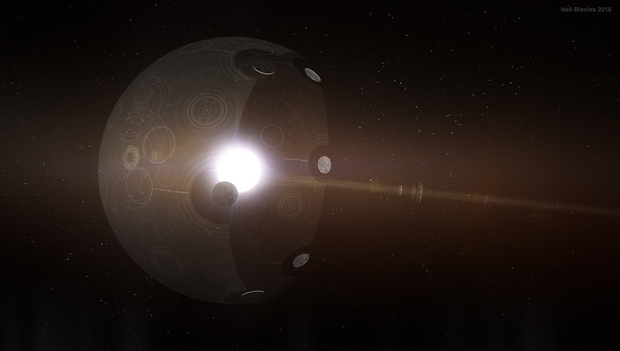
Image: A Shkadov thruster at work. Credit: Greg School.
Let’s give Shkadov his due before exploring Vidal’s new concept. A Shkadov thruster works through a balancing act. A semi-spherical mirror is positioned in such a way that the pressure of solar photons balances the gravitational force of the star on the mirror. Achieve this and the radiation hitting the mirror reflects back toward the star, producing an imbalance that creates thrust. Here’s a diagram from a paper by Duncan Forgan (University of Edinburgh) that is the best I can find to illustrate the concept:
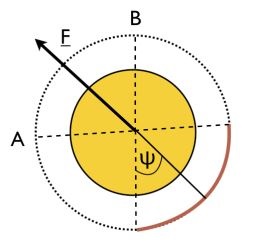
This is Figure 1 from Duncan Forgan’s paper “On the Possibility of Detecting Class A Stellar Engines Using Exoplanet Transit Curves (citation below).” The treatment of Shkadov thrusters is useful, and I insert the diagram here because the Vidal paper only offers a short explanation of the original concept. Forgan’s caption: Diagram of a Class A Stellar Engine, or Shkadov thruster. The star is viewed from the pole – the thruster is a spherical arc mirror (solid line), spanning a sector of total angular extent 2ψ. This produces an imbalance in the radiation pressure force produced by the star, resulting in a net thrust in the direction of the arrow. Credit: Duncan Forgan.
Clément Vidal brings into the stellar engine mix the idea of using binary millisecond pulsars. You may recall Vidal’s stellivore concept, which we’ve discussed over the years in Centauri Dreams. Here’s how he describes it in the current paper:
…the stellivore hypothesis, that reinterprets some observed accreting binary stars as advanced civilizations feeding on stars… The scenario would be the following. For most of its time, a stellivore civilization would eat its home star via accretion. However, energy is never eternal, and instead of eating its star until the end and dying, a stellivore civilization would use its low-mass companion star as fuel not to be accreted, but to be evaporated, in order to create thrust and travel towards a nearby star. The fundamental accretion dynamics of close binaries would be reversed into an evaporation dynamics.
In the new paper, Vidal homes in on so-called spider pulsars, which are binary systems made up of one millisecond pulsar and a low-mass companion star. This in itself has always struck me as an extraordinary situation. We’re positing a massive star in a binary system that becomes a supernova and leaves behind a neutron star. In many cases, the binary system (i.e., the companion star) survives this event, allowing the neutron star thereafter to draw material out of it through accretion. It’s this transfer of mass that ‘spins’ up the neutron star – this is simple transfer of angular momentum – so that the neutron star can rotate at millisecond rates.
I haven’t seen any figures on what percentage of binary systems can survive a supernova event, but it’s telling that a high proportion of millisecond pulsars are indeed found in binary systems. Millisecond pulsars (MSPs) are detectable when the beam of electromagnetic radiation they emit sweeps past our observing apparatus.
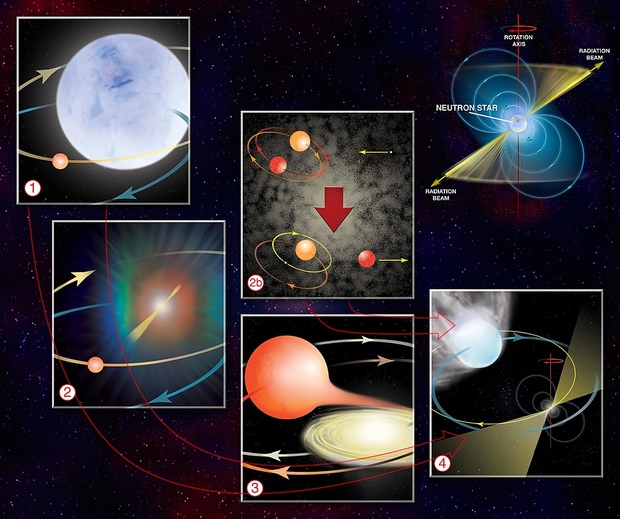
Image: This diagram shows the steps astronomers say are needed to create a pulsar with a superfast spin. 1. A massive supergiant star and a “normal” Sun-like star orbit each other. 2. The massive star explodes, leaving a pulsar that eventually slows down, turns off, and becomes a cooling neutron star. 3. The Sun-like star eventually expands, spilling material on to the neutron star. This “accretion” speeds up the neutron star’s spin. 4. Accretion ends, the neutron star is “recycled” into a millisecond pulsar. But in a densely packed globular cluster (2b)… The lowest mass stars are ejected, the remaining normal stars evolve, and the “recycling” scenario (3-4) takes place, creating many millisecond pulsars. Credit: B. Saxton, NRAO/AUI/NSF.
A spider pulsar as described by Vidal is made up of a one millisecond pulsar and a relatively small companion. And here we get the unusual evaporation effect that the above quote references. Rather than accreting matter from the companion star, a spider pulsar system evaporates the companion star. Hence the ‘spider’ metaphor, referring to female spiders that eat their male companion after mating. Get the right configuration and you have what Vidal calls a spider stellar engine. How it can be used to accelerate, decelerate and steer over interstellar distances takes up much of the paper. More on that next time.
In this kind of engine, the payload is a neutron star of about 1.8 solar masses. The propellant is the low-mass companion star somewhere between 0.01 and 0.7 solar masses. And where are the passengers; i.e., the civilization that is transporting itself around the galaxy? We have a lot to discuss here, and I also want to dig into the Hooper paper referenced above as well as the subject of hypervelocity stars, which are possible instances of stellar engineering technosignatures. We continue next time, with an email exchange I’ve been having with Vidal and the fine-tuning of stellar engines.
Clément Vidal’s new paper is “The Spider Stellar Engine: a Fully Steerable Extraterrestrial Design?” Journal of the British Interplanetary Society Vol. 77 (2024), 156-166 (preprint). Leonid Shkadov’s original paper on the Shkadov thruster is “Possibility of controlling solar system motion in the galaxy,” 38th Congress of IAF,” October 10-17, 1987, Brighton, UK, paper IAA-87-613. The Forgan paper is “On the Possibility of Detecting Class A Stellar Engines Using Exoplanet Transit Curves,” accepted at the Journal of the British Interplanetary Society (preprint).

Habitability and a Variable Young Sun
Given our intense scrutiny of planets around other stars, I find it interesting how little we know even now about the history of our own Sun, and its varying effects on habitability. A chapter in an upcoming (wildly overpriced) Elsevier title called The Archean Earth is informative on the matter, especially insofar as it illuminates which issues most affect habitability and how the values for these vary over time. It’s also a fascinating look at changing conditions on Venus, Earth and Mars.
We know a great deal about the three worlds from our local and planetary explorations, but all too little when it comes to explaining the evolution of their atmospheres and interior structures. But it’s important to dig into all this because as Stephen Kane, director of The Planetary Research Laboratory at UC-Riverside and colleagues point out, we seem to be looking at the end state of habitability on both Mars and Venus, meaning that our explorations of these worlds should yield insights into managing our own future. Powerful lessons are likely to emerge, some obvious, some obscure.
The chapter title is “Our Solar System Neighborhood: Three Diverging Tales of Planetary Habitability and Windows to Earth’s Past and Future” (citation below), from which this:
Resolving the numerous remaining questions regarding the conditions and properties of our local inventory of rocky worlds is… critical for informing planetary models that show how surface conditions can reach equilibrium states that are either temperate and habitable, or hostile with thick and/or eroded atmospheres.
Given the challenges of working at the Venusian surface, Mars is particularly valuable as a case study, a world that has evolved through a period of habitability (is this true of Venus?) and undergone interior changes including cooling, not to mention loss of atmosphere. The more we learn about the evolution of rocky worlds, the more we will be able to apply these discoveries to planets around other stars. We’re in search of models, in other words, that show how planets can reach equilibrium as habitable or hostile.
The Archean eon (roughly 4 to 2.5 billion years in extent) takes us through the formation of landmasses, Earth’s early ‘reducing’ atmosphere (light on oxygen but rich in methane, ammonia, hydrogen carbon dioxide) and all the way to the emergence of life. So we have plenty to work with, but for today I want to focus on one aspect of habitability that we haven’t discussed all that often, the changes in the Sun since Earth’s formation. Our G-class star had to progress through a protostar stage lasting, perhaps, 100,000 years or more, then a T-tauri phase likely lasting 10 million years. There’s a lot going on here, including shedding angular momentum as the young Sun expels mass, slowing its rotation rate and producing a powerful solar wind.
The Sun’s arrival on the main sequence follows, and we’re immediately involved in a singularly vexing astronomical puzzle. The consensus seems to be that the early main sequence Sun was only about 70 percent as bright as the star we see today. That being the case, how do we account for the fact that water appears early in Earth’s history in liquid form on the surface? The expectation of a frozen world is a natural one, yet liquid water at the surface seems to have been available for some four billion years.
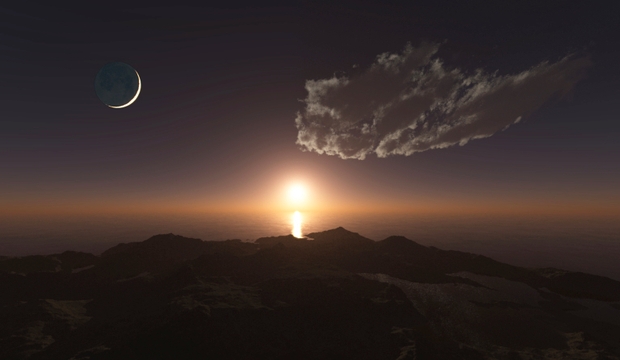
Image: The landscape during the early Archean could have looked like this: small continents on a planet mostly covered by oceans, illuminated by the much fainter young Sun, and with a Moon that appears larger in the sky because of its smaller distance to Earth. Credit: Potsdam Institute for Climate Impact Research.
Infant stars in the T-tauri phase are quite bright, getting their energy primarily from gravitational contraction. When they reach the main sequence and hydrostatic equilibrium sets in, they are considerably dimmer. The Sun enters the main sequence undergoing stable hydrogen fusion, which drives its luminosity. The notion that the Sun was dimmer early in the main sequence derives from models showing a solar core that is less dense and contains less helium. As core density increases as hydrogen is converted to helium, the resultant heating accounts for the steady brightening since.
Carl Sagan was an early voice in exploring the ‘faint young Sun’ problem in relation to liquid water and the matter is still controversial, although a number of possibilities exist. The authors believe the logical way to explain why a fainter star could provide conditions for liquid water on the surface is through the presence of greenhouse gases like methane and carbon dioxide, although the influence of methane is problematic unless, as in recent papers, scientists invoke planetary impacts or a primitive photosynthetic biosphere that amplifies the methane cycle. Whatever the case, mechanisms to regulate habitability are clearly crucial. From the chapter:
It is remarkable that Earth seems to have become habitable within its first few hundreds of millions of years and maintained that state seemingly without interruption to the present. This persistence is a testimony to the power of feedbacks that drive and regulate climate evolution with notable success on Earth in comparison with our Solar System neighbors Venus and Mars. Most important is the silicate weathering negative feedback, whereby rising temperatures coinciding with a warming Sun are offset by increasing rates of CO2 consumption through continental weathering, which is enhanced under warmer, wetter conditions. And we can thank diverse plate tectonic processes and their roles in such carbon cycling for this sustained thermostatic capacity over much of our history.
But let’s return to that very early Sun emerging onto the main sequence. Factors affecting a young star’s luminosity include the rotation rate of the star, and here we have little information (the Sun’s rotational rate in this era is uncertain, although some evidence suggests that it was a slow rotator). But the earliest planets could have been pummeled by radiation in this early state for tens or even hundreds of millions of years, which would have had a dire effect on any atmospheres they had formed. Note this:
…the intensity of the emission depends on the rotation rates of the stars, which are highly variable (from observation of stars in <500 Myr old stellar clusters). “Fast rotating” young stars can reach about a hundred times the rotation rate of the modern Sun, whereas moderate rotators could rotate at about ten times that rate and slow rotators would reach a few times the Sun’s rotation rate (Tu et al., 2015). Corresponding luminosities for young stars in the EUV and X-ray range of the spectrum can reach on the order of a 1000 times present mean solar luminosity at similar wavelengths for fast rotators, a few 100 times for moderate rotators and between a few tens to a hundred times the reference for slow rotators.
We’ve looked before at both the solar wind and solar flares as factors influencing planetary atmospheres and interacting with their magnetic fields, perhaps stripping atmospheres entirely in the case of M-class planets orbiting tightly around their primary. Atmospheric escape takes two forms, the first being thermal loss, where atoms are accelerated to the point where they reach escape velocity. Intense radiation is one but not the only way of doing this, but the effect on an atmosphere can be dire.
Other processes that can adversely affect an atmosphere include ions being accelerated along magnetic field lines by the solar wind or photochemical reactions. You would think that these effects would vary with distance from the star, but as the authors note, the loss estimates for Mars, Venus and Earth are relatively similar, and this despite the major differences in the makeup of the atmospheres on these planets and their magnetic field situation. Mars lacks a protective magnetic field today but seems to have had one in the past. Venus likewise lacks an intrinsic magnetic field like that produced on Earth through its convective dynamo, although interactions between the solar wind and the CO2-rich atmosphere do produce a weak magnetic effect.
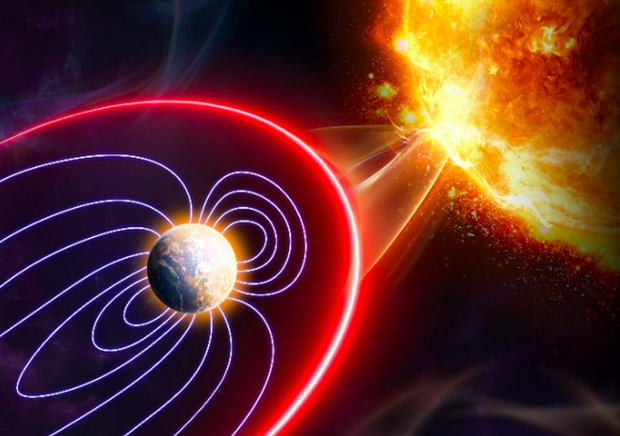
Image: Diagramming a solar flare encountering Earth’s magnetosphere. Credit: Jing Liu (Shandong University, China and National Center for Atmospheric Research in the U.S).
As to the Sun, variations in the solar magnetic field over time are assumed given that a faster spinning star would have produced higher levels of magnetic activity. Today’s solar cycle, eleven years long, is the result of the magnetic reversal cycle of the Sun. The twists and tangles of magnetic field lines during this cycle cause sunspot activity to peak and then decline as the north and south magnetic poles reverse. The Sun’s magnetic field strengthens and weakens during the cycle, with effects apparent in the solar wind itself and in spectacular events like coronal mass ejections.
If we back out to the largest timescales, the variations in the Sun’s magnetic field indicate a much stronger field early in the Sun’s evolution, coupled with a (presumed) faster stellar rotation rate. From the standpoint of habitability, that tells us that ultraviolet and X-ray flux along with the solar wind has been decreasing with time. We’re probably talking about orders of magnitude difference in UV and X-ray radiation, but the authors point out that the intensity of emission depends upon the rotation rate of stars, and there is much we still have to learn about both this and luminosity.
The high degree of uncertainty on the Sun’s rotation rate and temperature affect our estimates of the ultraviolet at X-ray emissions our star would have produced, and thus the impact of this flux on the atmospheres of the terrestrial planets. Enlarging our field of view to exoplanets, it’s clear that the more we can piece together about the Sun’s early history, the more we can learn about the atmospheres and habitability of planets around the various spectral types of stars. Kane and team see the Sun as a template for planetary evolution, which makes heliophysics crucial for the study of astrobiology.
This study, then, homes in on the factors that need to be clarified as both heliophysics and exoplanetary science move forward. Even the closest planet to us presents formidable challenges, and the authors’ discussion of Venus is well worth your time. Here we have a world whose young surface – relatively uniform in the range of 250 to 1000 million years old – makes digging into its more remote past all the more difficult. Evidence can only be indirect at this stage of planetary exploration. We’re lucky to have Mars within reach as we widen the study of planetary formation to worlds other than our own.
The chapter in the Elsevier book is Kane et al., “Our Solar System Neighborhood: Three Diverging Tales of Planetary Habitability and Windows to Earth’s Past and Future,” available as a preprint. Two Sagan papers on the faint young Sun paradox are notable: Sagan & Mullen, “Earth and Mars: Evolution of Atmospheres and Surface Temperatures”, Science 177 (1972), 52 (abstract) and Sagan & Chyba, “The early faint sun paradox: Organic shielding of ultraviolet-labile greenhouse gases,” Science 276 (1997), 1217 (abstract). You might also want to look at Ozaki et al., “Effects of primitive photosynthesis on Earth’s early climate system,” Nature Geoscience 11 (2018), 55-59 (abstract), which offers up a methane solution for the faint young Sun.

Vega’s Puzzling Disk
Over the weekend I learned about Joseph Haydn’s Symphony No. 47, unusual in that it offers up some of its treasures in perfect symmetry. Dubbed ‘The Palindrome,’ the symphony’s third movement, Minuetto e Trio, is crafted to play identically whether attacked normally – moving forward through the score – or backwards. You can check this out for yourself in this YouTube video, or on this non-auditory reference.
The pleasure of unexpected symmetry is profound, and when seen through the eyes of our spacecraft, can be startling. Consider the storied star Vega. We see this system from our perspective at a very low inclination angle relative to its rotational axis, as if we were looking down from above the star’s pole. This face-on perspective is profoundly interesting when examined through our space-borne astronomical assets. In the image below, we get two views of Vega’s disk, from Hubble and then JWST.

Image: The disk around Vega as seen by Hubble (left) and Webb (right). Hubble detects reflected light from dust the size of smoke particles largely in a halo on the periphery of the 160-billion-kilometer-wide disk. Webb resolves the glow of warm dust in a disk halo, at 37 billion kilometers out. The outer disk (analogous to the solar system’s Kuiper Belt) extends from 11 billion kilometers to 24 billion kilometers. The inner disk extends from the inner edge of the outer disk down to close proximity to the star. Credit: NASA, ESA, CSA, STScI, S. Wolff (University of Arizona), K. Su (University of Arizona), A. Gáspár (University of Arizona).
We don’t, of course, have the perfect symmetry of the Haydn minuet and trio here, but do notice how smooth this disk appears, and particularly take note of the lack of any embedded planets, the sort of large objects we observe in formation around stars like Beta Pictoris. This bright star, a summer object in Lyra for those of us in the northern hemisphere, was well studied in the infrared by astronomers using the Spitzer Space Telescope, and now we have the clearest view ever, the subject of two upcoming papers in The Astrophysical Journal. Co-author Andras Gáspár (Steward Observatory, University of Arizona, calls the Vega disk “ridiculously smooth.”
The view shows layered structure, with Hubble detecting dust on the outer regions of the disk and Webb’s infrared view resolving the warmer dust in the inner disk, the disk in this region being sand-sized as compared to the outer halo, whose particles are of the consistency of smoke. These are useful observations because they offer information on dust movement in circumstellar disks, and also point out the stark difference among the planetary disks thus far observed. The hot, A-class Vega at 450 million years old remains a relatively young star and we would expect interactions among debris in the disk to keep replenishing it, a process that continues in our own much older system.
But where are the planets in formation? Lead author Kate Su (University of Arizona), says that the lack of them forces astronomers to rethink the way they’ve looked at forming planetary systems. It’s possible to tease out a gap at about 60 AU, but everywhere else the disk appears smooth, which rules out planets larger than Neptune in outer orbits. Adds Su:
“We’re seeing in detail how much variety there is among circumstellar disks, and how that variety is tied into the underlying planetary systems. We’re finding a lot out about the planetary systems — even when we can’t see what might be hidden planets. There’s still a lot of unknowns in the planet-formation process, and I think these new observations of Vega are going to help constrain models of planet formation.”
In the second of the two papers, lead author Schuyler Wolff (University of Arizona) and colleagues home in on the star Fomalhaut by way of comparison, this being a star that is a close twin to Vega in terms of luminosity, distance and age. As the paper notes, “[T]he Vega disk morphology differs significantly from Fomalhaut,” going on to say:
Vega’s fellow archetypical disk, Fomalhaut, has been extensively studied in scattered light (Kalas et al. 2005; Gáspár & Rieke 2020) and shows a narrow cold belt from 130-150 au (possibly confined by an undetected planet e.g., Boley et al. 2012) with a scattered light halo extending outwards from the belt. The parent planetesimal belt is clearly detected with ALMA (MacGregor et al. 2017), with an estimated dust mass of 0.015±0.010M⊕. Fomalhaut has also recently been the target of groundbreaking JWST observations (Gáspár et al. 2023) showing the same narrow cold belt (albeit with a slight radial offset indicative of grain size stratification) and halo.
Indeed, Fomalhaut appears to be building a planet within its debris disk, and possibly more than one, these objects acting as ‘shepherds’ shaping the disk. Any such worlds in the Vega system are clearly much smaller, if indeed they exist. Vega’s dust distribution is broad, whereas at Fomalhaut the outer debris ring is the dominant source of light available for our observation. Three nested debris belts appear at Fomalhaut.
Nothing better than a new astronomical puzzle, especially when it challenges our notions of planet formation. You may remember Vega’s role in Heinlein’s Have Spacesuit Will Travel (1958), where its civilization acts as a kind of overseer for Earth, and perhaps the ‘Vegan Tyranny’ from James Blish’s Cities in Flight series. For that matter, Vega has an important commercial role in Asimov (the source of ‘Vegan tobacco’ in the Foundation books), appears prominently in Jack Vance’s work, and is of course of great interest to Ellie Arroway in Carl Sagan’s book and film Contact. How enjoyable that it now throws a new mystery at us.
The papers are Su et al., “Imaging of the Vega Debris System using JWST/MIRI,” accepted at The Astrophysical Journal (preprint) and Wolff et al., “Deep Search for a scattered light dust halo around Vega with the Hubble Space Telescope,” accepted at The Astrophysical Journal (preprint).


